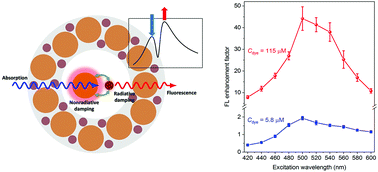Manipulating the fluorescence of exciton–plasmon hybrids in the strong coupling regime with dual resonance enhancements†
Abstract
Strong couplings between molecular excitons and metal plasmons bring advantages to effectively manipulate the optical properties of hybrid systems, including both absorption and fluorescence. In contrast to absorption behaviours, which have been quite well understood and can be categorized into different regimes such as Fano dip and Rabi splitting, the characteristics of fluorescence in strongly coupled hybrids remain largely unexplored. Quenching instead of the enhancement of fluorescence is usually observed in the corresponding experiments, and a theoretical model to deal with this phenomenon is still lacking. Herein, we demonstrate a largely enhanced fluorescence in a hybrid system with Cy5 dye molecules strongly coupled to Ag nanoparticle films, signified by the huge Rabi splitting absorption spectra. The plexciton Rabi splitting of the hybrids can be tuned from 320 meV to as large as 750 meV by adjusting both plasmon strength and molecular concentration. Moreover, when the excitation and emission wavelengths are respectively tuned to be resonant with the two Rabi peaks, the hybrid acting as a plexcitonic dual resonant antenna exhibits an enhanced fluorescence 44 times larger than that of the free dye molecule. We also develop a theoretical model to simultaneously study the characteristics of both the absorption and emission spectra, including the peak shifting and strength. These findings offer a new strategy to design and fabricate plexcitonic devices with tunable optical responses and efficient fluorescence.



 Please wait while we load your content...
Please wait while we load your content...